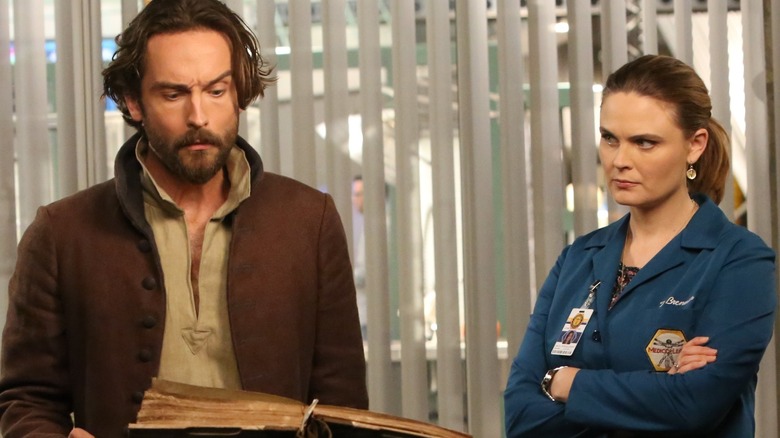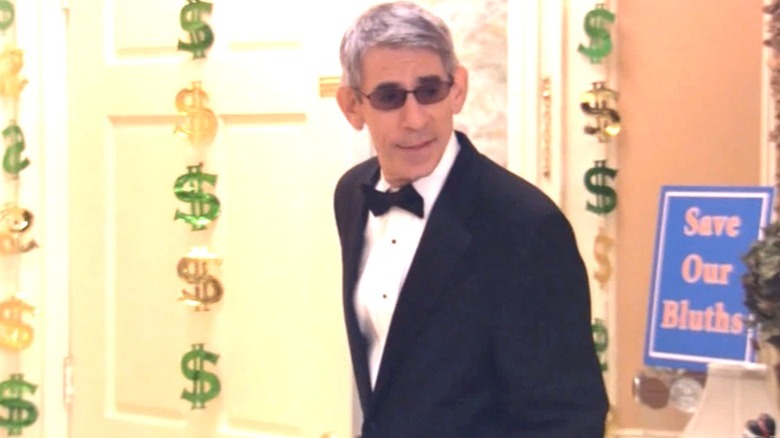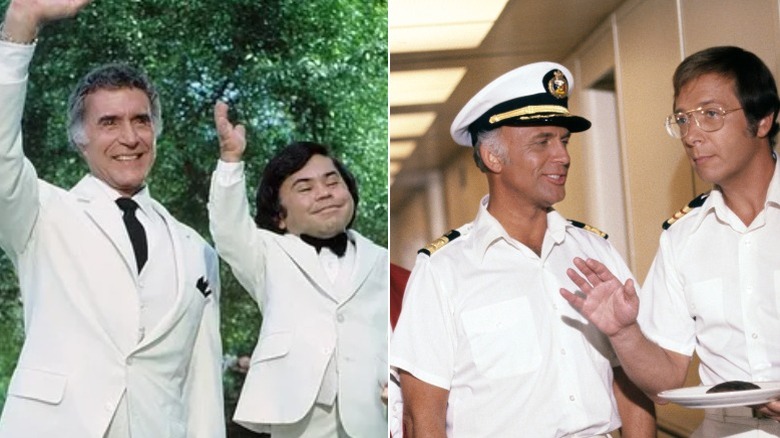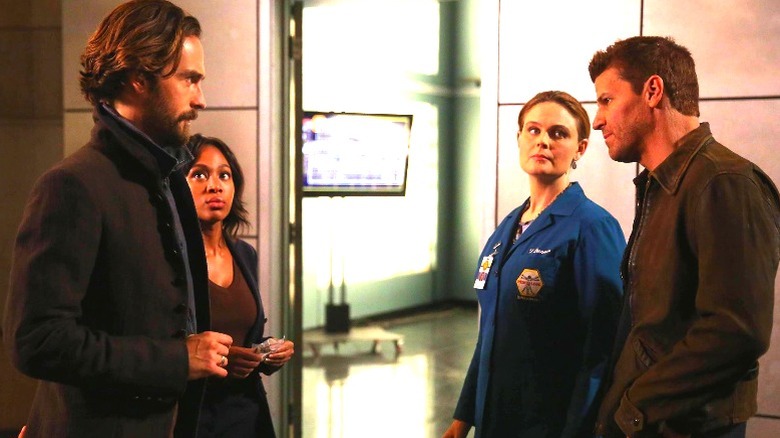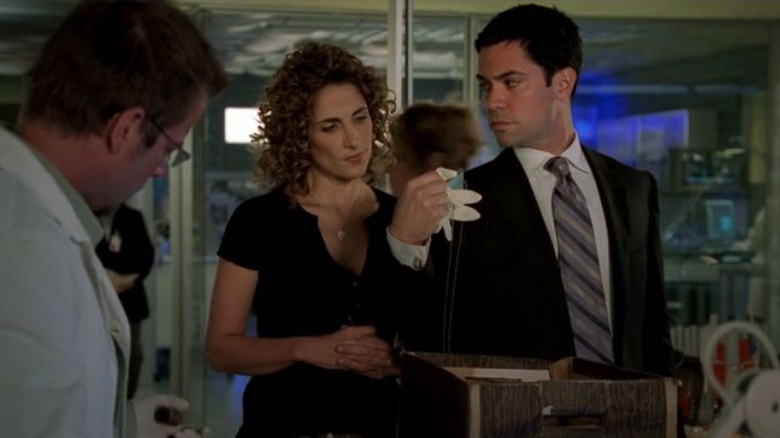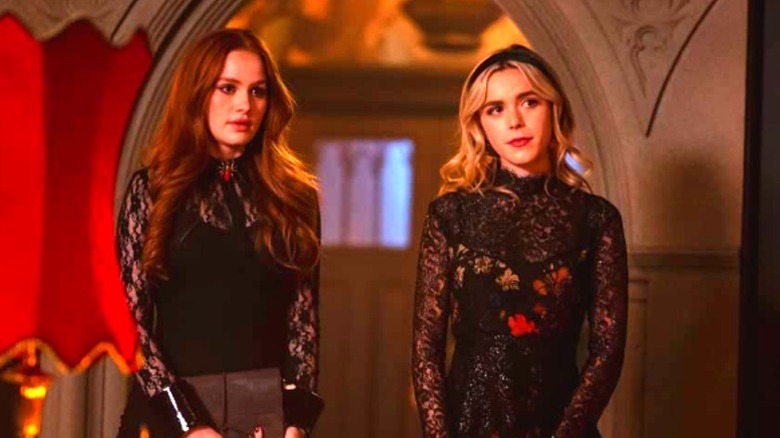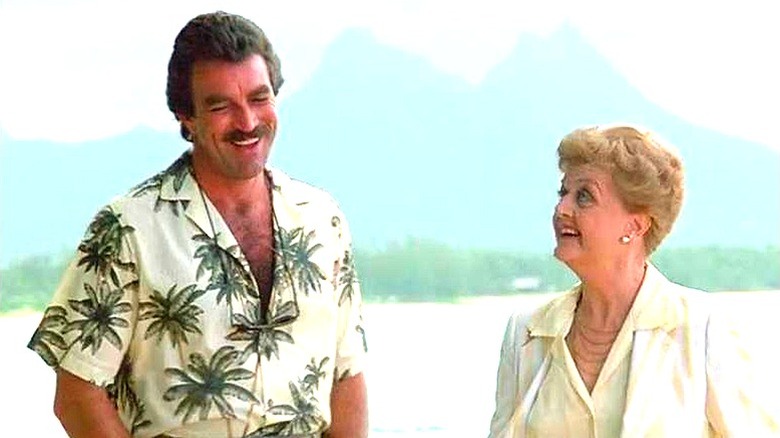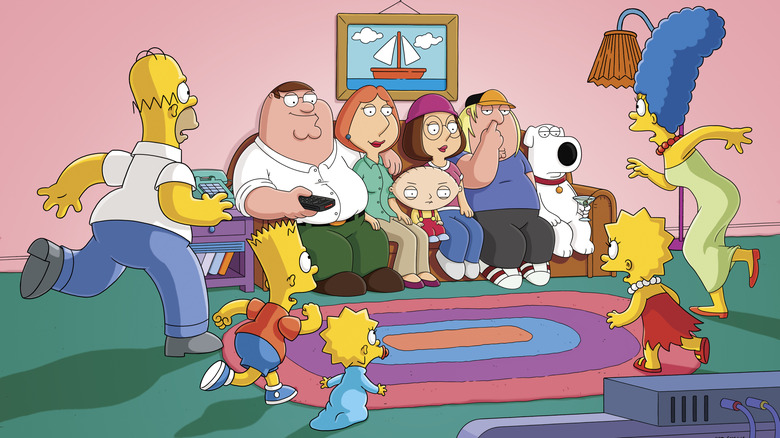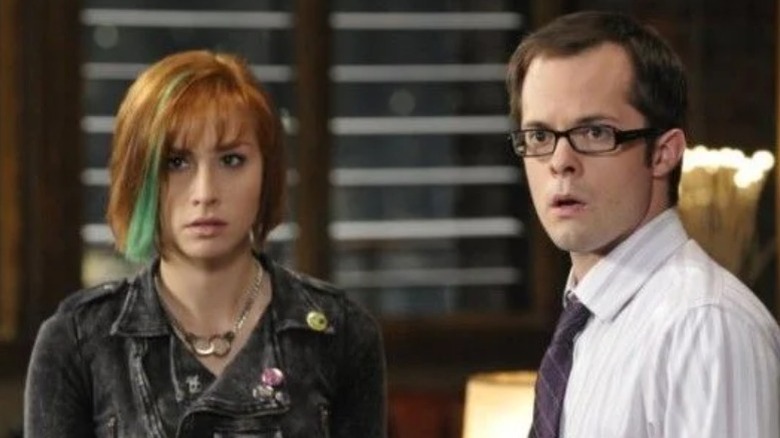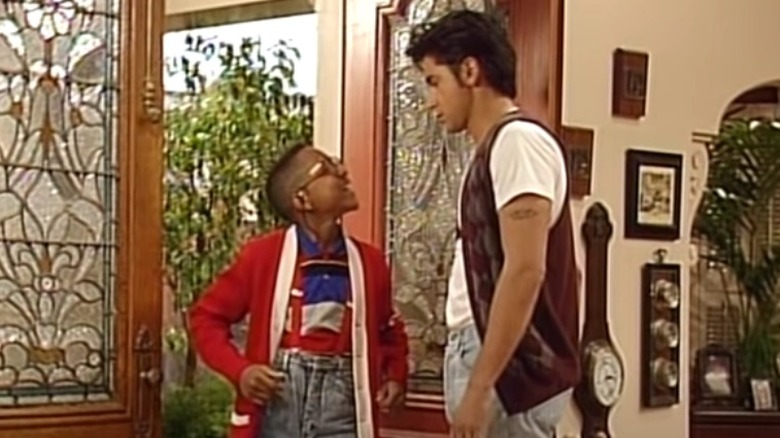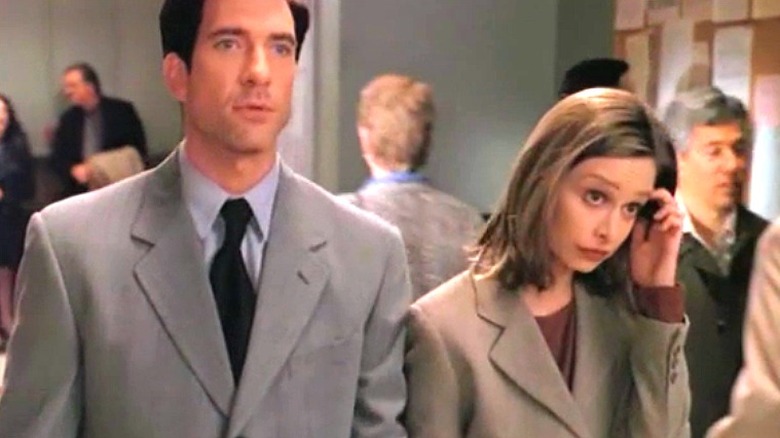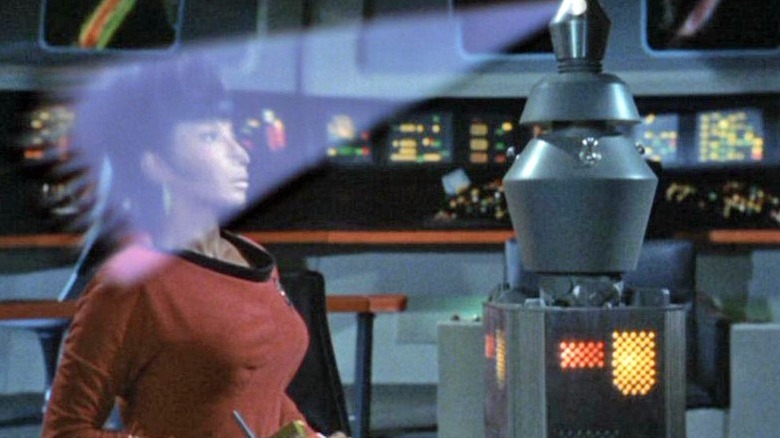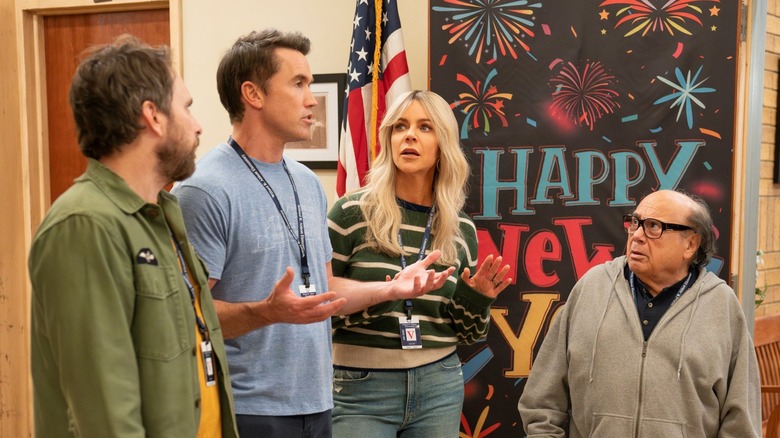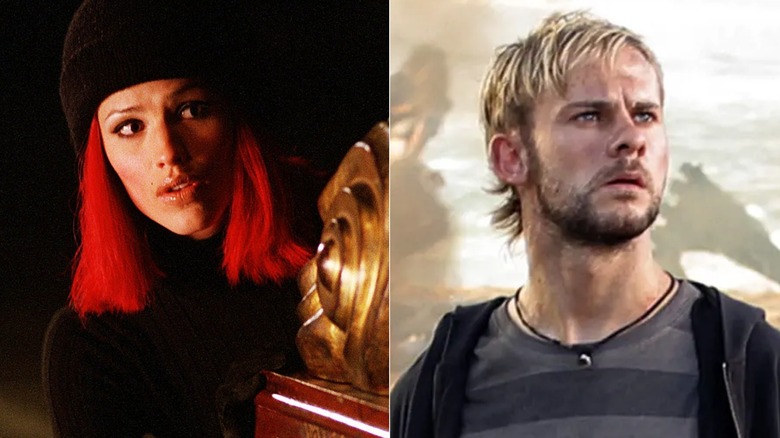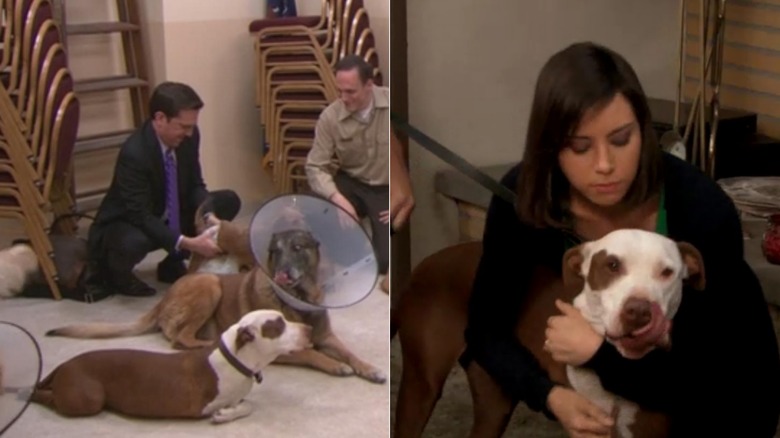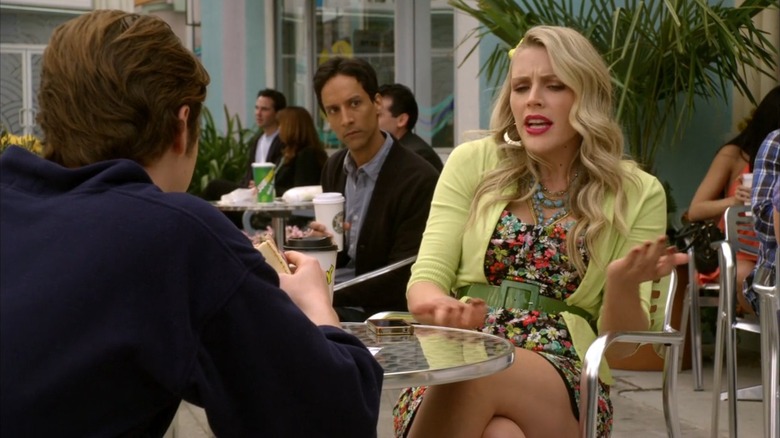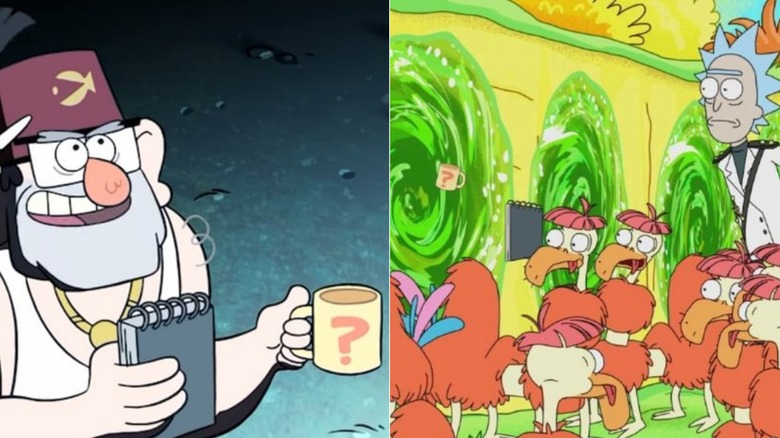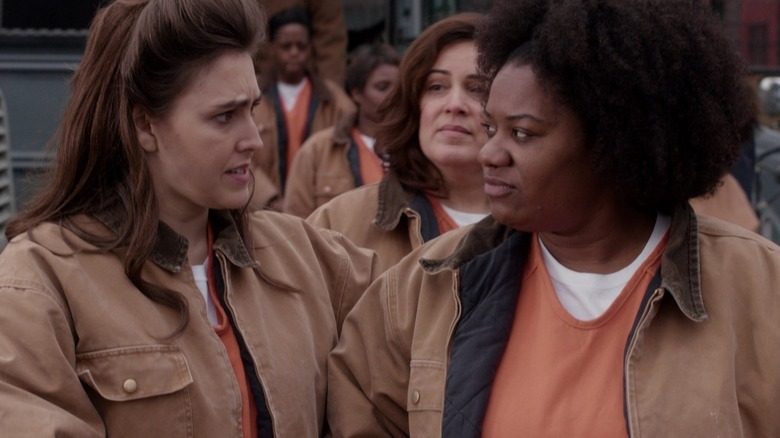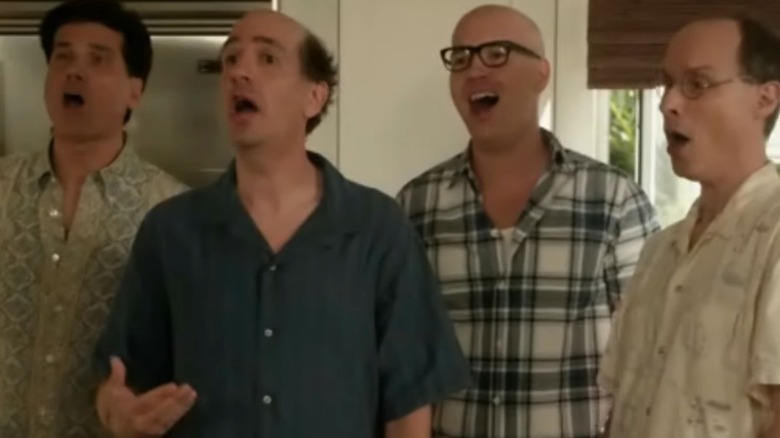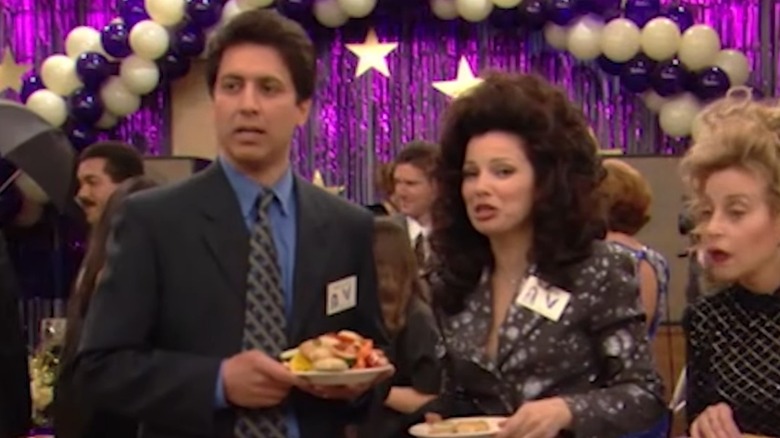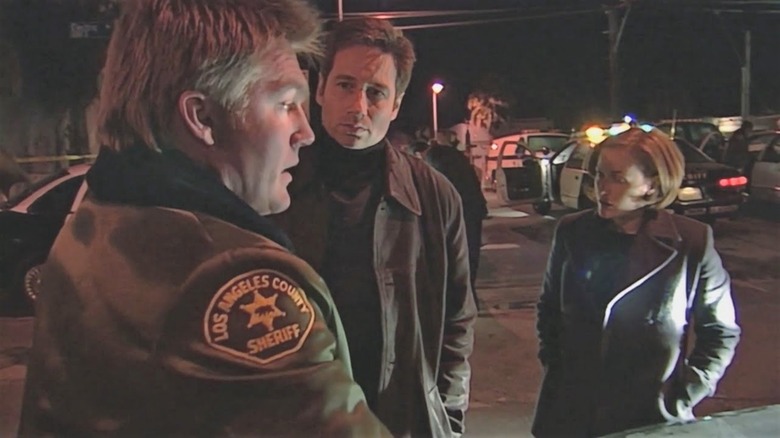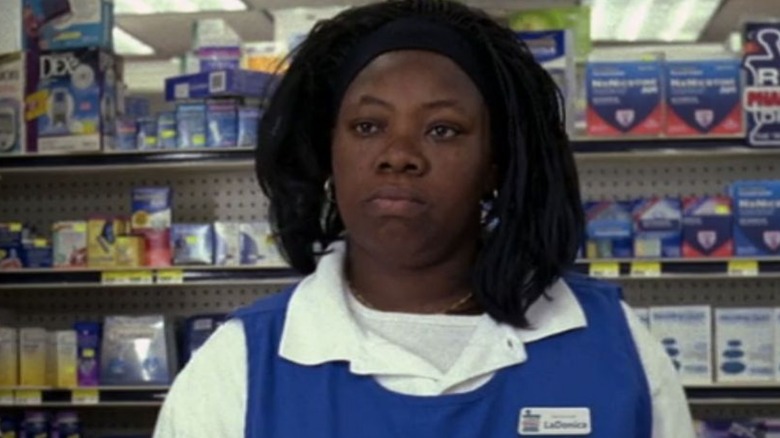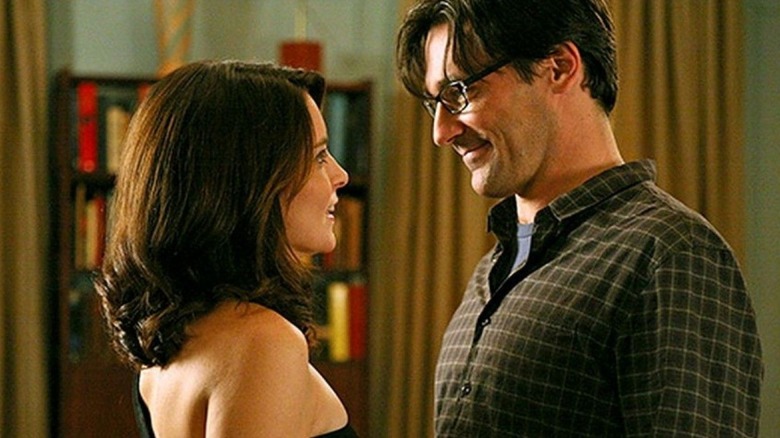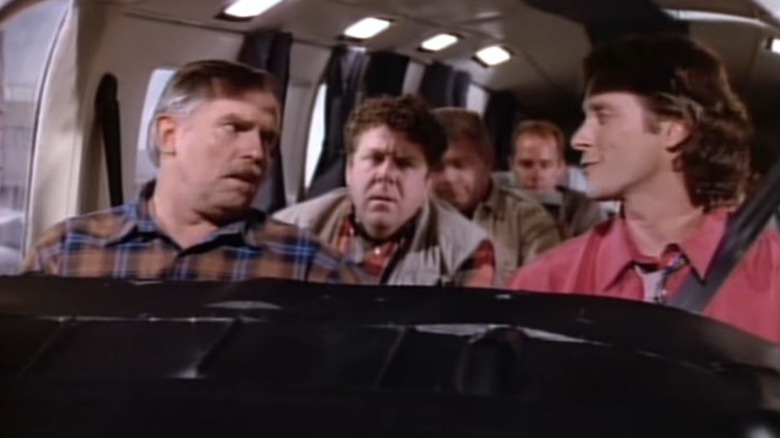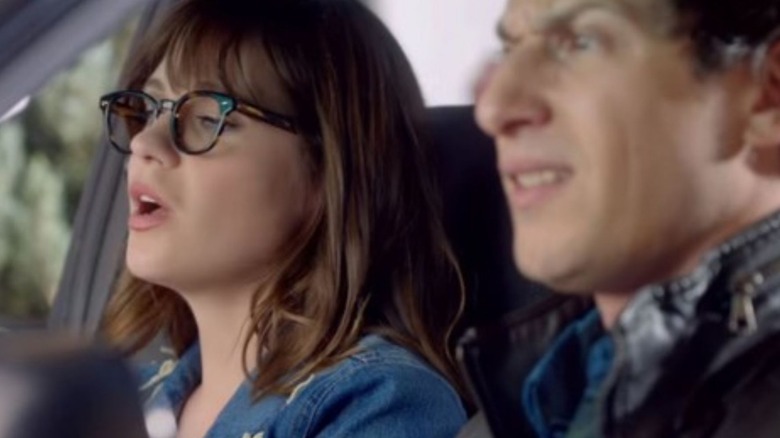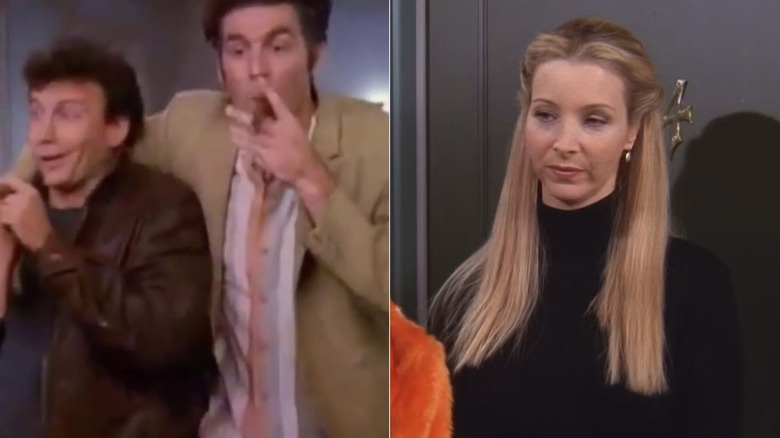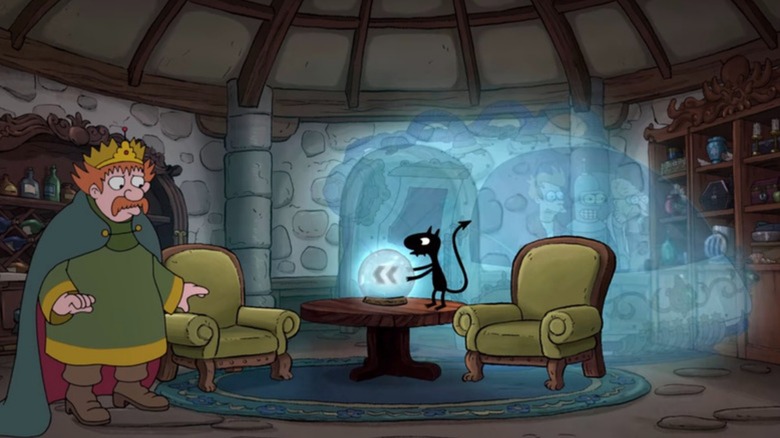TV Shows You Didn't Know Share A Universe
There's nothing quite like getting into a good TV show. Whether we're tuning in week after week or binging the whole thing at once, the characters we've come to know and love over time can start to feel like our best friend or even our mortal enemy. And every once in a while when the stars shine just right, the television gods smile upon us by bringing together two or more of our favorite TV shows.
As the writing wizards behind Marvel know all too well, whether it's in the form of shared lore, character swaps, or that holy grail of network television, the crossover episode, there's nothing quite as mind-blowing as realizing that two beloved TV shows are set in the same shared universe. And apparently, TV writers love writing it just as much as we enjoy watching it because more television shows than most of us realize are set in expanded TV universes. From sitcom swaps to mystery mashups, check out these favorite TV shows you didn't know share a universe.
Homicide: Life on the Street and Arrested Development
In the vast world of police procedurals, one fictional detective — Richard Belzer's Detective John Munch — has managed to drift throughout the wider television multiverse over the past few decades including, surprisingly, the world of "Arrested Development."
According to "Law and Order" creator Dick Wolf, the whole thing started when he and Tom Fontana of "Homicide: Life on the Street" struck up a friendship while working in the same building during the late '80s (via TelevisionAcademy.com). Despite their two shows being quite different, Wolf says the pair dreamed up a crossover "mostly for the annoyance factor." Even if the actual implementation turned out to be "logistically a nightmare" and NBC didn't want to pay for it, the crossover was such a success that it turned out to be just the beginning of Munch's world-hopping.
Through the years, Munch appeared in 10 different TV shows, crossing into different networks, genres, and styles of television, including "Arrested Development." In the critically-acclaimed comedy series, Munch shows up undercover as part of a CIA sting operation, disguised as a scrapbooking class teacher with designs on getting dirt on the Bluths. Along with the detective's other appearances, this means the same wider universe includes "The X-FIles," "The Beat," "The Wire," and "Law and Order."
Love Boat and Fantasy Island
If you were in the market for feel-good storytelling in a vacation setting during the late 1970s to early '80s, "Fantasy Island" and "The Love Boat" had you covered. Set on the dreamy MS Pacific Princess, "The Love Boat" followed guests as they set sail on the high seas, their minds on adventure and their course on a new romance with help from Captain Stubing's friendly crew. For most of its run, the series aired back-to-back with "Fantasy Island," in which Ricardo Montalbán of "Khannnn!" fame starred as the enigmatic Mr. Roarke who, with help from his sidekick Tattoo (Hervé Villechaize) and seemingly supernatural forces, brings guests' fantasies to life — usually along with a valuable life lesson.
With such similar settings and themes, it was only a matter of time before viewers got confirmation that the two shows shared a universe. It came in a 1980 episode of "Fantasy Island." After seeing off a pair of guests, Tattoo pulls out a photo of the Pacific Princess, telling Mr. Roarke it's his fantasy to visit the Love Boat. Although Mr. Roarke says he's not sure if he can get Tattoo on board, he promises to bring the boat to Tattoo someday soon. Seeing as Vicki (Jill Whelan) of "The Love Boat" would later pull out a photo of Fantasy Island, it's safe to say the two vacation destinations existed in the same fictional universe even if we never did get to see Tattoo make that pleasure cruise.
Bones and Sleepy Hollow
Throughout its 12 seasons on the air, the lighthearted cozy mystery-meets-forensics procedural "Bones" was more than just a character-driven comfort show. It also gave viewers a chance to get an inside look at the world of forensic archaeology and anthropology with the help of Dr. Temperance "Bones" Brennan's (Emily Deschanel) team of science geeks at the Jeffersonian Institute Medico-Legal Lab located in Washington, D.C. And thanks to two very special crossover episodes, it turns out supernatural shenanigans are canon in the "Bones" universe.
Like "Bones," the supernatural horror series "Sleepy Hollow" picked up an avid following during its short run thanks to its witty writing, rich lore, and memorable ensemble cast. The fish-out-of-water tale found Revolutionary-era Renaissance man Ichabod Crane (Tom Mison) facing off against demonic forces working to bring about the apocalypse. Although the series was not moved to the D.C. area until its fourth season, fans of both shows were treated to a Halloween crossover tale beginning with the Season 11 "Bones" episode, "The Resurrection in the Remains," and wrapping up in the Season 3 "Sleepy Hollow" episode, "Dead Men Tell No Tales."
The expanded universe actually contains three series thanks to the short-lived "Bones" spin-off series, "The Finder," a Florida-based tale of a retired army sergeant whose TBI inexplicably grants him the near-supernatural ability to locate just about anything.
Cold Case and CSI: New York
One of television's longest-running procedural franchises is the "CSI" universe. It first originating with the 2000 flagship series, "CSI: Crime Scene Investigation," which spent 15 seasons on the air and spawned several spin-off shows, including "CSI: Miami," "CSI: NY," "CSI: Cyber," and "CSI: Vegas." Through the years, this has yielded its own set of in-franchise crossovers, like the three-part "CSI: Trilogy" tie-in that spanned "CSI," "NY," and "Miami." But it's also part of a larger shared universe that includes "Cold Case," "Without a Trace," and weirdly, "Two and a Half Men."
The first in the trio of non-CSI crossovers, "CSI: NY" and "Cold Case" crossover episode, "Cold Reveal," begins when Philadelphia detective Scotty Valens (Danny Pino) of "Cold Case" reveals DNA from "CSI:NY" detective Stella (Melina Kanakaredes) came up in a Philly cold case. In pursuit of answers, he travels to the Big Apple, where the two detectives end up searching for the truth together. The show's parent series, "CSI," would later cross over with "Without a Trace" in a two-part episode spanning both shows. And in 2008, a two-part crossover featuring "CSI" and "Two and a Half Men" would officially put the collective "Cold Case," "Without a Trace," and "CSI" universe in the world of the popular sitcom.
Pretty Little Liars: Original Sin, Riverdale, and Chilling Adventures of Sabrina
The world of Archie Comics has come a long way since it first arrived in 1941. The flagship series, "Archie," featuring all-American teens Archibald "Chick" Andrews, Betty Cooper, and Jughead Jones, led to a much wider comic book universe that included Josie and the Pussycats and Sabrina the Teenage Witch. Over the years, a whole slew of adaptations arose from the Archieverse, from animated TV shows like "Sabrina: Secrets of a Teenage Witch" to the film adaptation of "Josie and the Pussycats." But the franchise took a much more creative departure with its 2017 supernatural horror and crime drama series, "Riverdale," adapted for The CW by Roberto Aguirre-Sacasa.
First envisioned as a John Hughes-inspired teen adventure, the concept for "Riverdale" evolved into something more David Lynchian before hitting the airwaves. "Chilling Adventures of Sabrina" was meant to serve as a companion series, with Sabrina (Kiernan Shipka) even making an appearance on "Riverdale" on Season 6 of the series. And according to Roberto Aguirre-Sacasa, both shows share a universe with "Pretty Little Liars: Original Sin" and presumably, its parent series, "Pretty Little Liars."
Although brief, the reference comes when the Liars' investigation leads them to a clue involving "the Sisters of Quiet Mercy over in Riverdale." Confirming the connection, Aguirre-Sacasa told TVLine the writers didn't know if they could leave the reference in, but since no one objected, "I guess it does exist in the same universe." Fan theorists, go wild.
Magnum, P.I. and Murder, She Wrote
With his tiny shorts, party-ready mustache, wealthy benefactor, and candy apple red Ferrari, Thomas Magnum (Tom Selleck) of "Magnum, P.I." epitomized the 1980s cool detective aesthetic as he chased down his latest private investigation all over Oahu. Magnum's energy was pretty much the polar opposite of another 1980s detective, Maine-based retired teacher-turned-mystery writer Jessica Fletcher (Angela Lansbury) of "Murder, She Wrote." But the two shows had more in common than their status as network hits or the fact that they both had commas in their names — they also existed in the same TV universe.
A two-part crossover episode spaned both series, beginning with the "Murder, She Wrote" episode "Magnum on Ice," and ending in the "Magnum" episode "Novel Connection." The two-parter sends Jessica to Hawaii after Magnum is accused of a murder-for-hire plot, and the pair end up working together to find the real killer. "Magnum" also shares a connection with "Simon and Simon" through a similar two-part crossover. Although rumors of a planned "Magnum, P.I." and "Quantum Leap" crossover that have haunted the Internet for decades seem to be just that, the fact that the Simons, Jessica Fletcher, and Thomas Magnum are all out there solving mysteries in a shared universe still makes for some pretty fun storytelling.
Family Guy and The Simpsons
The creators of "South Park" may find "Family Guy" exasperating, but "The Simpsons" team seems to have a more magnanimous take on their fellow Fox animators, with the two shows occasionally engaging in some back-and-forth shout-outs that go beyond mere references or parodies through the years. For Seth MacFarlane and company, who owe a debt of gratitude to the elder series, the chance to take those references up a step with a full-fledged hour-long crossover episode in 2014 must have been a dream come true.
In an Entertainment Weekly interview with MacFarlane and "The Simpsons" creator Matt Groening, MacFarlane credited "The Simpsons" with inspiring his path forward, emphasizing, "I'm the first person to say, stylistically, absolutely, we took 100 cues from The Simpsons." According to the "Family Guy" creator, Rich Appel, who worked on both series, spearheaded the team-up — a "Family Guy" episode in the style of "The Simpsons" featuring characters from Springfield.
The episode follows the Griffins as they travel to Springfield, where they cross paths with the Simpsons. While Peter and Homer search for the Griffins' car, Bart and Stewie end up making prank calls together, Lisa connects with Meg, and Marge and Lois find they have a lot in common when it comes to their husbands. While hardly the best episode in either show, "Simpsons Guy" was a dream come true for fans of both shows while establishing their place in the same TV universe as canon.
Eureka and Warehouse 13
These days, there aren't nearly enough quirky, episodic sci-fi and fantasy shows on the air. But from the mid-2000s through roughly 2016, fans could find a wealth of this lighthearted fare in shows like "The Librarians," "Haven," and "The Magicians." So the fact that two of the more beloved SyFy series in that category, "Eureka" and "Warehouse 13," existed in a shared universe meant fans of the genre were constantly in for a treat. And it makes sense since their stories seem to go together naturally.
Set in the town of Eureka, Oregon, "Eureka" takes place in a secretive world populated by the scientific geniuses behind Global Dynamics, the company responsible for some of humanity's most recent technological breakthroughs. "Warehouse 13" deals with a pair of U.S. Secret Service agents tasked with rounding up supernaturally charged artifacts and storing them in their own hidden HQ.
Their shared universe is referenced throughout both TV shows, going far beyond the occasional cameo or casually-dropped reference. Eureka researcher Douglas Fargo (Neil Grayston) shows up at Warehouse 13 more than once ("13.1," "Don't Hate the Player"), while Warehouse 13's Claudia Donovan (Allison Scagliotti) and Hugo Miller (Rene Auberjonois) make their own journeys to Eureka ("Crossing Over," "13.1").
Full House and Family Matters
Anyone who had access to network TV during the '90s will likely feel a wave of nostalgia at the mention of ABC's TGIF (Thank Goodness It's Funny), the Friday night sitcom block responsible for generating a host of laugh-tracked TV shows. With their Randy Newman theme songs, inoffensive family-friendly comedy, and occasional Very Special Episodes, these shows were the perfect way to round off the week by tuning into the latest shenanigans of an unconditionally loving All-American family.
But only the most dedicated TGIF viewers knew that all their favorite TV shows were actually set in the same universe, with many of them spinning off from other series in the lineup. And occasionally, they'd even get treated to the ultimate sitcom experience: the crossover episode, like when Steve Urkel (Jaleel White) from "Family Matters" dropped by to visit the Tanner family in the 1991 "Full House" episode "Stephanie Gets Framed" to ask for cheese, strut with Jesse (John Stamos), and offer a freshly bespectacled Stephanie (Jodie Sweetin) some terrible advice.
Thanks to this and other crossovers, the list of TV shows set in the same universe would become fairly expansive, eventually including series like "Step By Step" and "Boys Meets World," while fueling fan theories like the Grand Steve time travel theory, thanks to Urkel's canon time travel machine.
Ally McBeal and The Practice
Former Boston-area attorney-turned-TV-producer David E. Kelley has been responsible for bringing some of television's best dramas to the small screen over the years in shows like "Chicago Hope," "Picket Fences," and "Big Sky." Falling under the category of "write what you know," several of his most popular series are set in Boston and happen to be part of a shared TV universe. First airing in 1997, "Ally McBeal" was ahead of its time as a pioneer of cringe and surreal comedy. Starring Calista Flockhart, the series found its eponymous character navigating the strange sexual politics of a Boston law firm with a unisex bathroom.
Premiering the same year, "The Practice" was a comedy-drama also set in a Boston law firm that starred Dylan McDermott as its ethically torn partner Bobby Donnell. Confirming their shared universe, both shows had quite a few characters in common, including Boston judges Seymore Walsh (Albert Hall), Jennifer Cone (Dyan Cannon), and Roberta Kittleson (Holland Taylor).
Main characters from both shows also crossed over to the other series from time to time. Most of the main cast from "The Practice" stopped by "Ally McBeal" in the Season 1 episode "The Inmates," with the "Ally McBeal" folks coming over to "The Practice" to wrap up the story on the Season 2 segment, "Axe Murderer." The wider Kelleyverse also includes a handful of other series, such as "Boston Public," "Boston Legal," and the medical drama "Gideon's Crossing."
Star Trek and Team Knight Rider
When TV writers reference other works that have influenced their storytelling, it can add layers to the narrative or even lead to new fan theories, like when Walter Bishop (John Noble) of "Fringe" mentions the glasses he got from Dr. Jacoby (Russ Tamblyn) of Washington, teasing that "Fringe" exists in the "Twin Peaks" universe. While they're usually a treat, occasionally fans get a clumsily-handled TV allusion that feels shoehorned in, leaving fans scratching their heads at why writers worked so hard to force something that didn't feel right. Such was the case when a "Team Knight Rider" episode suggested that it shared a universe with "Star Trek."
This connection begins with the 1967 "Star Trek" episode, "The Changeling," in which the Enterprise crew confronts the deadly sentient space probe Nomad, which originated centuries earlier from Earth. When the probe mistakes Jim Kirk's (William Shatner) name for that of his creator, Jackson Roykirk, it realizes that, like everything else it's meant to destroy, Nomad itself is imperfect and must destroy itself.
Nomad has been called one of the "Trek" franchise's best villains — which is apparently why the writers of "Team Knight Rider" tried to write it into their show. One episode in the "Knight Rider" sequel deals with a killer sentient space probe invented by none other than Jackson Roykirk. While it's a one-sided reference, it's not quite enough to warrant shipping K.I.T.T. with the Enterprise computer.
Abbott Elementary and It's Always Sunny in Philadelphia
"Abbott Elementary" and "It's Always Sunny in Philadelphia" are two incredibly popular shows set in the city of brotherly love, but they're as dissimilar as you can get. One is about the staff of an underfunded Philadelphia elementary school that goes above and beyond to help their kids in any way possible, and the other covers the objectively ruinous lives of five wildly self-destructive narcissists.
Despite their incongruous premises, the two series crossed over with each other in 2025. This was fan service of the highest order, and it played out in a rather creative way. In "Abbott Elementary" Season 4, Episode 9, "Volunteers," the school welcomes the "It's Always Sunny" gang, who are there to help the teachers and give something back — court-ordered, of course.
This thrusts both casts together in a hilarious mashup of two wildly different comedies, though Charlie (Charlie Day) from "Sunny" has the biggest story in the "Abbott" episode. Fortunately, the crossover isn't a one-and-done sort of thing: the "Abbott" staff reciprocated by hanging out at Paddy's Pub with the "Sunny" crew in Season 17's premiere episode.
Alias and Lost
For a time in the 2000s, it seemed you couldn't escape hearing about the TV series "Lost." Fans argued over the hidden meaning of it all and guessed at the true nature of the island. "Alias" premiered first and ran concurrently for a couple of years, starring Jennifer Garner as a spy-turned-double-agent who fights to reclaim her life.
The shows didn't seem to have much in common outside of their creator, J.J. Abrams. While Abrams could have engineered a crossover between his two hit series while they were on the air, he didn't do that — not exactly. Instead, he sprinkled in some hints of their shared universe in various subtle ways that most fans likely missed.
In "Lost," for example, Charlie (Dominic Monaghan) is a member of the moderately successful band Drive Shaft, which had a hit song, "You All Everybody," that's heard in various flashbacks on the show. Meanwhile in "Alias'" Season 4, Episode 3, "The Awful Truth," Sydney (Garner) hosts a party, and in one scene where she speaks with her father, Jack (Victor Garber), "You All Everybody" can be heard playing in the background, firmly placing the two shows in the same universe.
Parks and Recreation and The Office
"The Office" and "Parks and Recreation" are considered two of the greatest mockumentary series to ever hit the small screen. While both are comedies featuring highly skilled actors, "The Office" is set in the corporate world of the Dunder Mifflin Paper Company in Scranton, Pennsylvania, while "Parks and Rec" is a political satire set in a fictional small town in Indiana. The likelihood of these two shows coming into contact with each other seems impossible, but it turns out that they do share a universe — and confirmation of that comes thanks to a dog.
In Season 8, Episode 22 of "The Office," titled "Fundraiser," Andy (Ed Helms) adopts 12 dogs, one of which probably looks familiar to fans of "Parks and Rec." That's because the dog is none other than the three-legged pit bull Champion, the pup rescued by Andy (Chris Pratt) and April (Aubrey Plaza) from the Pawnee, Indiana, animal shelter. Champion appears in numerous episodes of "Parks and Rec" and is played by Lucy the Dog. There are other details that connect the two series — such as a Sabre printer from "The Office" showing up on "Parks and Rec" — but Champion may be the main link.
Community and Cougar Town
In a more meta example of worlds colliding, you have "Community" and "Cougar Town," two shows with little in common. "Community" is about a group of friends attending a community college and the wacky adventures they have there. The other is about a recently divorced woman navigating her 40s with the help of her friends.
Yet "Cougar Town" exists as a TV show in the "Community" universe, which isn't unusual — "The Big Bang Theory," for example, thrived on referencing numerous geek-favorite shows and movies. Still, it's unique because Abed (Danny Pudi) has a cameo in "Cougar Town" Season 2, Episode 21, "Something Good Coming: Part 1." Pudi is just there in the background of a shot and he's barely noticeable before inexplicably running off.
But his cameo is actually foreshadowed before that in "Community" Season 2, Episode 19, "Critical Film Studies." Abed sits with Jeff (Joel McHale) in a fancy restaurant for his birthday — in a homage to the film "My Dinner With Andre" – and explains in detail how he was able to appear as an extra on "Cougar Town," adding an embarrassing scatalogically-themed horror story into the mix. To even things out, the latter show's Dan Byrd and Busy Philipps have a cameo in "Community" Season 2, Episode 24, "For a Few Paintballs More."
Gravity Falls and Rick and Morty
Both "Gravity Falls" and "Rick and Morty" muck about with interdimensional portals, so it's not unusual that the two shows might collide. That said, they never did so overtly, only sprinkling in various Easter eggs to entice fans. That makes sense, seeing as one is an adult-themed sci-fi series about a drunken absentee grandfather and his grandson, while the other is a Disney show meant for children.
But "Rick and Morty" co-creator Justin Roiland and "Gravity Falls" creative force Alex Hirsch are close friends, and the creators found clever ways to tie their two shows together. The most glaring example comes in "Gravity Falls" Season 2, Episode 7, "Society of the Blind Eye," when Stan (Hirsch) loses a pen, notepad, and question-mark mug through a portal.
In one of the best episodes of "Rick and Morty,", Season 1, Episode 10, "Close Rick-Counters of the Rick Kind," Rick and Morty are chased by the Council of Ricks through a series of interdimensional portals. They finally make it to one area where they fire off decoy portals to throw off their pursuers — and in one of them, Stan's missing objects quietly fall through.
Unbreakable Kimmy Schmidt and Orange Is The New Black
Not many shows could crossover with something like "Orange Is The New Black," given its setting at a women's correctional facility. It certainly has little to nothing in common with "Unbreakable Kimmy Schmidt," which is about the always cheerful Kimmy (Ellie Kemper), who's rescued after being held underground by a cult for 15 years and restarts her life by moving to New York City.
Despite their obvious differences, the two shows found a way to commingle, thanks to the storyline in "Schmidt" continually referencing Kimmy's time spent in captivity, where she and others earned the nickname the "Indiana Mole Women." Gretchen (Lauren Adams) was held alongside Kimmy but has a tough time acclimating to normal life, so she does the only thing she can think of and starts a cult for teenage boys.
Eventually, her compound is raided, sentenced to prison and briefly seen entering Litchfield Penitentiary in Season 3, Episode 5, "Kimmy Steps on a Crack!" That's the prison from "Orange Is The New Black," where she also meets Black Cindy (Adrienne C. Moore) from "Orange" and decides to try the cult thing again on the inside, only this time with women.
Cougar Town and Scrubs
When two shows feature the same actors, it's not uncommon for some similarities to pop up, but "Cougar Town" took it to the next level. The show featured many of the same actors who starred in "Scrubs," including Christa Miller, Ken Jenkins, Sarah Chalke, and Sam Lloyd — even "Cougar Town" star Courteney Cox had a three-episode role in "Scrubs." Of course, their characters are different in the series, with both shows created or co-created by Bill Lawrence.
That's a lot of crossover of talent, and it didn't take long for "Cougar Town" to provide some hefty fan service in the form of alternate and identical characters from "Scrubs." In "Cougar Town" Season 3, Episode 5, "A One Story Town," most of the major players from the medical comedy stop by for a fun series of cameos that include Lloyd's Ted from "Scrubs" rejoining his exuberant a cappella group.
Chalke and Miller also slip back into their "Scrubs" characters momentarily as Tom (Bob Clendenin) pops in to say hello. They're joined by Brian Bradley, Jenkins, Robert Maschio, Paul F. Perry, George Miserlis, Philip McNiven, and Zach Braff, who plays a pizza delivery man. It's a fun little aside that mashes the actors and their "Scrubs" characters into a completely different setting.
Everybody Loves Raymond and The Nanny
There were tons of entertaining sitcoms in the 1990s, and two of the biggest were "The Nanny" and "Everybody Loves Raymond." Fran Drescher played Fran, the titular nanny in her series, while Ray Romano played the lead in his. The shows weren't entirely dissimilar, and they found a way to cross over with each other due to the fact that Romano and Drescher attended the same high school in real life.
In "The Nanny" Season 5, Episode 18, "The Reunion Show," Fran returns to her old high school for a reunion, where she happens to run into Raymond Barone (Romano) and have a brief interaction. She even proclaims that "everybody loved Raymond" when another woman mentions she had a crush on him, just so there's no ambiguity there as to whether or not the two shows share the same universe.
Additionally, the school featured in the episode, Hillcrest High School, is the name of the institution Drescher and Romano attended and graduated from in 1975.
Cops and The X-Files
If there's one show on television that shouldn't have crossed over with another, it's "Cops." The reality TV series ran for 37 seasons, consisting of over 1,200 episodes, but it's not episodic, nor does it feature recurring characters. "The X-Files," on the other hand, has a cast of regular characters, is episodic, and isn't based on reality in any way due to its focus on two FBI agents investigating the paranormal.
Despite the entirely different formats, the two shows managed to do a crossover. This is especially impressive given the extensive "X-Files" mythology and lore, which doesn't jibe with regular police work. The two shows shared a universe via Season 7, Episode 12, "X-Cops," which plays out in real-time as Scully (Gillian Anderson) and Mulder (David Duchovny) search for a shapeshifter.
Throughout their investigation, they're chronicled by the film crew from the TV series "Cops," and the whole thing plays out as if it's not an "X-Files" episode but a "Cops" one instead. It even opens with a modified "Cops" disclaimer and Inner Circle's "Bad Boys" playing during the intro. It's quite possible some folks tuned in to watch "The X-Files" and thought they'd accidentally stumbled across an episode of "Cops."
30 Rock and Unbreakable Kimmy Schmidt
"30 Rock" and "Unbreakable Kimmy Schmidt" are tied together through a number of actors, plus Tina Fey helped create and was the showrunner for both of them. There was bound to be some crossover between the two that placed them in the same universe. But while major actors like Jane Krakowski and Jon Hamm appeared in both series, they played different characters in each and were not the real connection.
Instead, it's a woman named LaDonica who works in a drugstore and first appeared in "30 Rock" Season 1, Episode 7, "Tracy Does Conan." Kenneth (Jack McBrayer) tries to solve Tracy's (Tracy Morgan) medication issue and runs afoul of the humorless clerk, telling her, "Frankly, LaDonica, you have not been real helpful."
In "Unbreakable Kimmy Schmidt" Season 2, Episode 4, "Kimmy Gives Up!," Jacqueline (Krakowski) explains to Kimmy (Ellie Kemper) over the phone, "I'll go to the drugstore myself, despite the fact the last time I was in a drugstore was in 2004, and an employee named LaDonica said to me, '[Expletive], I don't know your life," which is perfectly on-brand for the briefly seen character.
Mad Men and 30 Rock
"Mad Men" made Jon Hamm a star, and when it ended, he branched out into comedy, finding his way onto Tina Fey's sets in both "The Unbreakable Kimmy Schmidt" and "30 Rock." In the latter, Hamm plays Dr. Drew Baird, one of Liz's (Fey) boyfriends. But while Hamm is just one of many celebrity cameos in "30 Rock," and also does appear in "Kimmy Schmidt," there's more to it than that.
In "Mad Men" Season 6, Episode 4, "To Have and to Hold," Ted (Kevin Rahm) orders an Old Spanish, which is a beverage found in both "30 Rock" and "Kimmy Schmidt." The drink in question was created by Matthew Broderick's character in "30 Rock" and consists of "red wine with tonic water and olives."
Other mentions that tie the two together occur throughout the series. In one segment on "30 Rock," Kenneth blurts out, "My real name is Dick Whitman," which is Don Draper's (Hamm) true identity in "Mad Men." In another episode, Liz's mom mentions once working as a secretary for Sterling Cooper, the firm that is the setting for "Mad Men." There are so many clues spread throughout each series that it's undeniable that they share a universe.
Cheers and Wings
Throughout much of its run, "Cheers" was a ratings juggernaut that enjoyed multiple spinoffs, including "Frasier." It also found itself in the same universe as "Wings," which wasn't as big a hit for NBC, but was no slouch either. "Wings" ran for eight seasons, and it wasn't rare to see some of the characters from "Cheers" stop by for an episode or two. That's partly due to the nearby common locations of each show.
"Cheers" is set in Boston, Massachusetts, while "Wings" is about 100 miles southeast in Nantucket, Massachusetts. Every so often, Cliff (John Ratzenberger), Norm (George Wendt), Rebecca (Kirstie Alley), Frasier (Kelsey Grammer), or Lilith (Bebe Neuwirth) would pass through the small airport in Nantucket and hop on Sandpiper Air's one and only airplane.
Inserting some of the characters from television's most popular series likely helped draw some eyeballs to "Wings," so it makes sense that NBC did that. Combined, "Cheers," "Wings," and "Frasier" are now part of what's known as the Frasierverse. Still, "Wings" wasn't a spinoff of "Cheers" despite some websites making that claim, and it only landed in the Frasierverse through its shared characters and common creators.
New Girl and Brooklyn Nine-Nine
In "New Girl," a quirky sitcom about relationships, Zooey Deschanel plays Jess, a woman who finds herself living with three men in a Los Angeles loft. Meanwhile, "Brooklyn Nine-Nine" is about a group of off-the-wall police officers from the titular New York City precinct and their unorthodox methods of investigating crimes.
The two found their way into the same universe via two episodes, one in each show. In "Brooklyn Nine-Nine" Season 4, Episode 4, "The Night Shift," and in "New Girl" Season 6, Episode 4, "Homecoming," both of which aired back-to-back, Jess begrudgingly helps "Brooklyn Nine-Nine" lead Jake (Andy Samberg) work a case. In a scene that has been memed to death, Jake attempts to commandeer Jess' car, but she refuses.
She goes along for the ride, and her car is damaged in the process. In "Homecoming," Jess meets the rest of the precinct while working with them to resolve her issue. It's a fun and unusual crossover that came out of left field, and fans of both shows got a treat seeing these characters interact in two Fox series that likely needed a ratings boost at the time.
Friends, Mad About You, and Seinfeld
In "Mad About You," the immensely successful sitcom that racked up eight seasons and 176 episodes, Lisa Kudrow initially played Ursula, an inept waitress who drives her customers nuts by forgetting orders and acting aloof. "Friends" premiered two years later, presenting a problem for Kudrow, who was cast as Phoebe in the latter show but couldn't play both characters at the same time. It turned out, however, that she could, as Ursula was reconceptualized to be Phoebe's twin sister.
But there's another connection that bridges these series together and also ropes in another incredibly popular '90s sitcom, "Seinfeld." In "Mad About You" Season 1, Episode 8, "The Apartment," Jamie (Helen Hunt) learns that Paul (Paul Reiser) still has his old apartment. He sublets it to Kramer (Michael Richards), and it's the same apartment the latter occupies in "Seinfeld." Kramer's a bit different in "Mad About You" — he's a hoarder and has a cat, among other things. Paul gives Kramer the apartment, pleasing Jamie and ensuring that "Friends," "Mad About You," and "Seinfeld" all exist in the same universe.
Futurama, The Simpsons, and Disenchantment
By 2025, "The Simpsons" had been on for 36 years and crossed over with several popular series throughout its hundreds of episodes. It featured the lead from "The Critic" in one episode, for example, but perhaps the best crossovers that tie "The Simpsons" to other animated shows come from the series' creator, Matt Groening, who also created "Futurama" and "Disenchantment."
There have been tons of little Easter eggs, legit crossover episodes, and casual mentions that connect these three series together. "Futurama" fans didn't miss noticing a big connection to "Disenchantment" in the show's Season 1, Episode 10, "Dreamland Falls," when in a blink-and-you'll-miss-it moment, you can see a time machine pop in and out of existence for a fraction of a second.
That time machine contains Fry, Bender, and Professor Farnsworth, who get lost in time in "Futurama" Season 6, Episode 7, "The Late Philip J. Fry." There's also a moment in "Disenchantment" where Fry's hair is visible, and Bender has popped into "The Simpsons" on several occasions. It all breaks down into a timeline where "The Simpsons" is chronologically followed by "Futurama," then "Disenchantment," which takes place far in the future.
